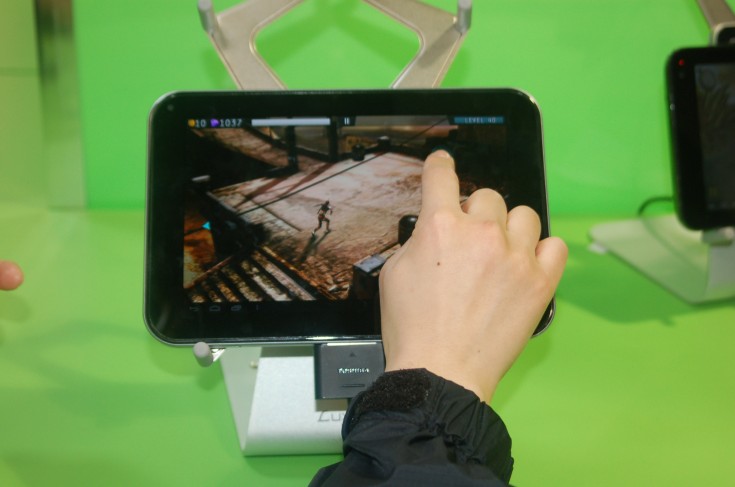
“For a long term, we will have an integration solution, a single SOC, which is codename “Grey”. Having a single chip, a Tegra processor chip plus (a baseband chip) will allow us to go into a mainstream market,” said Matt Wuebbling, director of product marketing, Tegra.
“On the other hand, we still strongly believe that high-end super-phone really want discrete applications processor and discrete modem (baseband) chips. It allows carriers to qualify modems and constantly let applications processors, or APs to improve,” added him.
According to him, for the second reason, more advances are happening on AP side, because CPU and GPU performances constantly have to be improved, let alone memory speed performances, to support constant updates in the specifications of peripherals like display resolution changes. Yet, he company doesn’t necessarily need to advance a modem performance as fast as APs.
So, the integration would drag its feet on CPU improvements.
He also pointed out that having the Icera modem as a discrete baseband chip not only allows Nvidia to go time to market, but also helps the chip maker to not only allows us to market, but also allow us to offer and expand our market for AP.
True enough, just in less than 9 months since its acquisition of Icera, Nvidia’s flahship application processor chips have been quickly moving into a mainstream market, having prized lots of design-wins from smartphone makers as well as tablet PC makers.
For example, Nvidia has supplied the Tegra AP chips for HTC to power HTC’s One X smart phones in what it said is the first big deal with the Taiwanese smartphone maker.
The chip maker also has inked a deal with LG Electronics, ZTE, Fujitsu, and Treasure to power LG Optimus 4X HD, ZTE Era, Fujitsu’s Ultra High Spec Smartphone, and the K-Touch Treasure V8.
For tablet PC markets, Nvida joined hands with Toshiba to supply its Tegra 3 chip for Toshiba’s 7.7 inch and 13.3-inch tablet PCs, while listing up Asus and ZTE as it ecosystem partners.
For example, Nvidia has got design-wins of Tegra 3 for Asus Transformer Pad 300 as wells ZTE’s 7-inch and 10-inch tablet PCs.
Director Matt Wuebbling attributed such rapid penetration of the Tegra 3 applications processor chips to what make differences with other competing AP chips.
The Tegra 3 AP is referred to as the industry’s first quad-core CPU and runs at speeds up to 1.5 GHz. Yet, it has one more variable core, which can not only work as a battery save core, but also a touch screen controller.
“The 4 core-plus-one architecture is why Tegra 3 is different from other APs,“ director Matt Wuebbling stressed. According to him, the beauty of Tegra 3 is its unique 4-PLUS-1 quad-core CPU architecture that not only delivers outstanding performance, but also big savings in battery life, plus a 12-core GPU, to deliver up to 5x the performance of the world’s first dual-core processor, Tegra 2.
Here is the imaginary picture of how Tegra’s fifth companion, or battery save core works to dramatic reduces power budget.
The Tegra 3 chip has a software algorithm which can automatically recognize and supervise system work flow. Then, the software algorithm allows the Tegra chip to automatically switch between 4 other main performance core and battery save companion core, putting heavy and active jobs on the main performance cores, while assigning the companions to do light and inactive job. For example, according to Direct Matt, the logic that drives the touch can be running on either low power core, or performance core, depending on how heavy task users are doing.
“For instance, if you are just holding a screen, the touch algorithm is running on a companion battery save core waiting for next action on a very low power mode, while your fourth performance core is off. , a companion shadow battery save core is on. Yet, once you touch, to start playing game, your battery save core turned off, and all of OS processing as well as touch processing transfer onto the performance core,” explained Director Matt.
The availability of Icera baseband modem chip has played big parts in its prize of my design-wins, too, as it allowed Nvidia to offer total solutions at an affordable price.
To make the choice of available baseband chips, especially for LTE, Nvidia is also joining hands with other baseband processor chip makers, including Renesas, GCT Semiconductor, and ST Ericsson.
To promote its DirectTouch technology, the chip maker is patterning with such touch screen controller titans as Atmel Corporation, Synaptics and Cypress Semiconductor. The DirectTouch technology is all about transferring and working out some parts of touch processing jobs on Tegra 3 host CPU chip.


